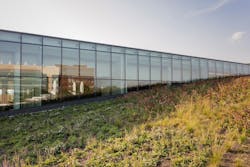Philadelphia Green Roof Embeds Charles Library Visitors in Nature
On the fourth floor of the new Charles Library at Temple University in Philadelphia, visitors will find an unexpected retreat that feels embedded in nature. The sun-filled space, glazed on all four sides with glass, offers views of a lushly planted green roof.
At 47,300 square feet, the sloping green roof covers 70% of the building’s roof surface, making it the second largest in Philadelphia and one of the largest in the state. It’s become a calming foreground for students and community members, while also playing a significant role in the building’s stormwater management system.
A Rain-Retaining Roof
The Charles Library’s roof was designed to capture and retain a maximum amount of rainwater not only from Temple’s campus, but also from Philadelphia’s aging infrastructure, which has been historically overburdened during storm events, notes Scott Sullivan, one of Stantec’s principal architects that worked on the 10-year project.
Stantec developed the building’s design in collaboration with Snøhetta. The international architecture and design firms incorporated the best of modern architecture, along with space- and energy-saving design into Charles Library’s interior and exterior.
- The green roof
- Pervious paved plazas and paths
- Landscaped planting beds that infiltrate rainwater
Sullivan notes there are also two underground catchment basins that together can store and process nearly 500,000 gallons of water during storm events. Altogether, he says the project manages all rainwater runoff on the roughly three-acre site, as well as for an additional acre of offsite impervious ground.
Creating Natural Habitats
Along with stormwater management, the green roof has become an amplified meadow landscape due to its differentiating soil levels. Sullivan says the fourth floor’s sloping roof comprises both extensive and intensive roofs.
The extensive portions are very shallow and use only three to four inches of soil. “If there’s a lot of rainwater, [the extensive roof] will slowly release it, otherwise the plants will suck it up,” Sullivan says.
The roof gardens include upwards of 15 different plant species, all of which now provide a rich urban habitat for pollinators like bees and butterflies, notes Sullivan.
“It’s wonderful because then when you’re on the [fourth] floor, you’re looking out onto this green roof with all these plantings, and it’s just a great thing to see all that nature that’s up there,” he says.
Green Roofs Can Lead to Certification
(Photo: One unexpected bonus of a green roof is its ability to become an Instagram-worthy space. Scott Sullivan, architect for Stantec, the firm that worked on the project, notes that the fourth floor of the Charles Library has become a hot-spot for students to take pictures of the gardens and the occasional praying mantis on the window. Credit: Michael Grimm Photography)
With its modern architecture and impressive roof landscape, the new Charles Library is sure to draw in visitors from both the campus and its surrounding community.
Two handpicked articles to read next:
About the Author

Adrian Schley
Staff Writer
Adrian Schley has been writing for interiors+sources magazine since March of 2018 and creates content for the BUILDINGS team. She earned her BA in journalism at the University of Iowa, where she also studied English.
